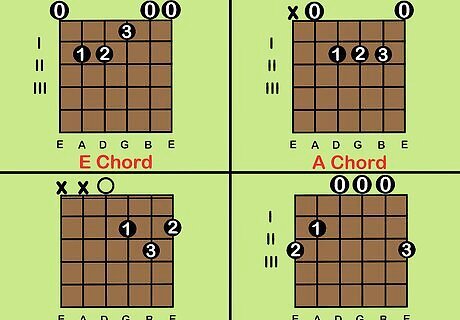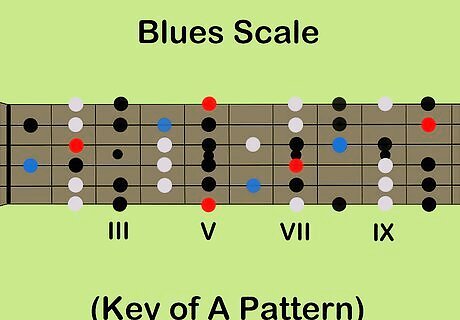
views

Learn the two basic Bar Chords: Much of Rock 'n' Roll uses nothing but two movable chords, called "bar chords." Once these two positions are learned, the chords are movable up and down the neck to play any major or minor chord. To play an A chord, for example, use bar chord #1 at the 5th fret. To play a D chord, either move bar chord #1 up to the D fret on the low E string, or use bar chord #2 on the 5th fret. Each of the two basic bar chords has a couple variations--for 7th, minor and minor 7th chords. Position #1: Index finger "barred" across all 6 strings, ring finger two frets up on the A string, pinky two frets up (same as ring finger) on the D string, and middle finger only one fret up on the G string. To make the chord minor, simply lift the middle finger off the G string. To make the chord a 7th chord, lift the pinky. To make it a minor 7th chord, lift both the middle finger and the pinky. Position #2: Index finger barred across the five upper strings (A, D, G, B, high E), ring finger barred two frets up across the D, G. and B strings. To make the chord a 7th, use the ring finger only on the D string and place pinky two frets up on the B string. To play a minor, place the ring finger on the D string, the pinky on the G string (right next to the ring finger, i.e., two frets up), and the middle finger on the B String. To play a minor 7th, use the ring finger on the D string and the middle finger on the B string (no finger on the G string other than the barred index finger).

Learn the most common Open Chords: These are the chords you see in any guitar chord chart. They are very useful for Rock 'n' Roll, depending on the style of song you want to play. The basic ones to know are E, A, D, G, and C. Don't even worry much about minors or 7ths, because those are just as easy to play as bar chords (see Step 1: Bar Chords). Open chords are especially useful for play arpeggios, picking one string at a time in a pattern among the notes of the chord.

Learn the Blues Scale: The essential scale for Rock 'n' Roll leads--playing solos--is the Blues Scale. It's simple as can be, and the pattern is movable (like the bar chords, see?) up and down the fretboard, depending on the key you want to play your solo in. Learn the pattern in the key of A, which is the fifth fret on the E string. Here is the pattern [Note: each finger corresponds to a fret: index is 1, middle is 2 (next fret), etc.]: low E string 1, 4; A string 1, 2, 3; D string 1, 3 (that's one octave); G string 1, 3, 4; B string 1, 4; high E 1 (that's two octaves). Practice this scale forever until it becomes fluid and second nature. Start playing around with it, using only the notes of the scale, but in whatever order you like. You'll soon see that 50% of Rock 'n' Roll leads never use anything but the blues scale.




















Comments
0 comment